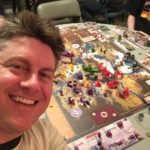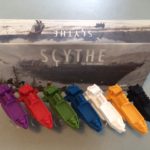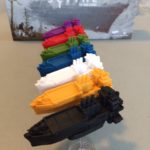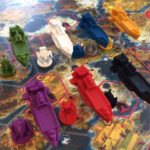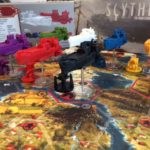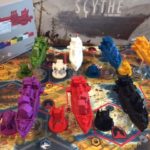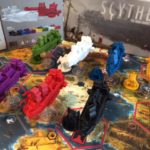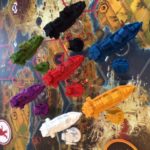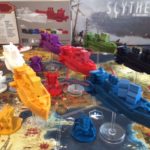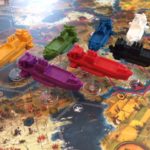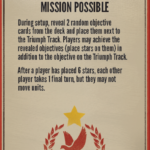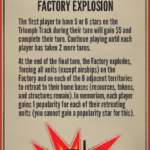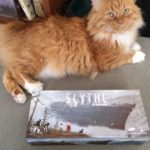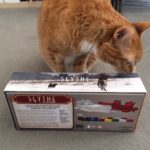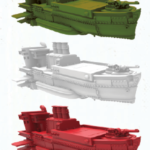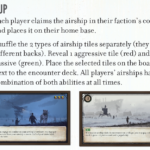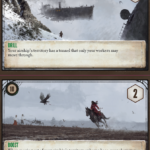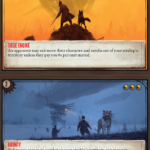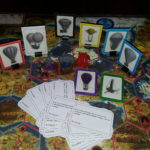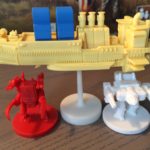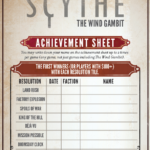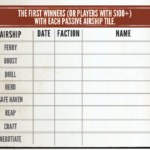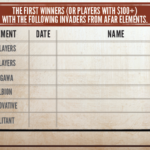This is a compilation of the designer diary entries Jamey posts on the Scythe Facebook group. They are listed here in chronological order, with the most recent entry at the top (so if you’re just now finding this, it’ll make more sense if you start from the bottom).
***
August 4
The final design diary post about The Wind Gambit is primarily about the Automa system, though I have two notes before we get to that:
1. Both the multiplayer and solo rulebooks are now available in a variety of languages (more languages to come).
2. The photos you see below are from the inaugural game of The Wind Gambit played at my game night on Wednesday. It was a 5-player game featuring a hodgepodge of various components and accessories. We had the Land Rush resolution tile and the airship abilities Drill and Distract, and we played on the regular board. I had a ton of fun as the Togawa player. Rusviet won with $61, followed by Polania with $60, Togawa with $58, Crimea with $50, and Albion with $24.
The following design diary entry is written by Morten Monrad Pedersen and is completely unrelated to the photos on this post.
***
If you’ve been following the news about The Wind Gambit, you’ll know that it consists of two modules: Airships (a new unit type) and Resolutions (new end game conditions).
At Automa Factory we looked at those from our usual perspective: The Automa must mimic the core interactions you have with another player and leave out everything else – the latter is done to make the Automa simple to handle.
The timing of the game end is a feature of Scythe, where players can be a deciding factor in who wins the game and so the race to achieve the end criteria is a core interaction point, which we should therefore support. Luckily 6 of the 8 resolutions worked with no changes, so our job was easy.
The airship abilities are divided into: Passive and aggressive. One of each is chosen and both apply to all airships in the game. The aggressive abilities are aimed at player interaction, while the passive aren’t interaction focused.
This clear distinction had done our work for us in identifying core interactions: We had to support the aggressive abilities for the Automa, but not the passive.
We concluded that we could keep the aggressive abilities (almost) unchanged for the human player, but changes were needed for the Automa.
Initially, we tried some fundamentally different approaches and after deciding on one of those we still had to experiment a lot to get it right. The playtesters were a great help with this. They came up with improvements and even extended the support from 6 of the aggressive abilities to 7.
In total, we ended up supporting 96% of the new resolutions and abilities from The Wind Gambit, which of course is 4% less than we’d like, but I still chalk it up as a success.
During the development of Scythe, we at Automa Factory made one of our Automas (artificial players) that allowed you to play the game solitaire against the Automa instead of a human player.
We got many requests for rules that would allow play with any combination of human and Automa players. We had considered this early in the design process, but since we live in the real world we must deliver a product before we die of old age) and we feared that we might not have enough time to do a well-polished system, since it would require much more playtesting, design and balancing, and so we decided to stick to a 1 vs. 1 system.
That said, we made sure not to do anything that prevent us from extending it and after delivering the core rules we did a semi-official any-player-combination variant and made it available as a free download. We didn’t put it through our normal playtest and polish process, since that would likely take a month or two of intensive work – time, we didn’t have – but luckily players have liked it.
The variant led to requests for selling extra sets of Automa decks, so, Jamey put some surplus Automa decks up for sale and to our surprise they sold out in no time. This happened again with another set of surplus decks and therefore Jamey ordered a separate print run of Automa decks.
At the time of writing the roughly 1400 extra Automa decks printed so far are sold (more are on the way) and if we added new cards to the deck those with extra decks would have to buy a set of the expansion cards per extra Automa deck they had. That is something we really wanted to avoid, so we made it a priority not to add or replace Automa deck cards.
We could of course have included 7 copies of any new Automa deck cards in the expansion, but that would increase the cost for the vast majority of players who do not use multiple Automa decks and that’s also a bad option.
In the end, we succeeded in making the expansion Automa so that it doesn’t require multiple copies of new cards, while still deliver the full Automa experience and we hope that all Automa players will agree that we made the right choice.
***
July 28
As you’ve probably already seen, I have some fun photos to share today. But before I get to that, I want to thank my co-designer, Kai, for his involvement in this expansion.
I’ve already told the story about how Kai shared the rules and early playtest results for the airship expansion back in December. It caught my eye, and I asked Kai if he wanted to work on a full expansion with me.
I’ve had the pleasure of working with other co-designers over the years—my business partner Alan and the great Uwe Rosenberg—and I’ve worked with designers as a developer on Between Two Cities and a few upcoming games. Everyone has a different collaborative style and work ethic, and it’s kind of always a gamble.
I was elated to learn that Kai is absolutely wonderful to work with. He’s hard-working and creative, just as his original post in this group suggested. He respected how well I know Scythe, but he still pushed back at the right times (it wouldn’t have worked out if he had constantly asked for justifications or demanded explanations for my tweaks). He was also great at looking through the wealth of blind playtest data to find trends and suggest changes.
So I just wanted to thank Kai for the hugely positive impact he had on The Wind Gambit—it literally would not exist without him. I’m proud to have his name on the box next to mine.
This is on my mind because yesterday I received a few sets of the final airship miniatures, and I sent one to Kai (he wants to try his hand at painting them). I love the way they look and feel. The clear plastic rod and base are removable, though right now the rod is a little tight, which we’ll be fixing without hurting the schedule.
***
July 21
Every game of Scythe ends the same way…until now.
Back in December when Kai and I started talking about airships, I mentioned to him that I would be interested in including something else in the expansion. I didn’t know what the “something” would be—rather, I just liked the idea of pairing two concepts into one expansion box, kind of like how Invaders from Afar adds 2 new factions AND 2 new player mats.
So I looked over my notes from the last year and saw some ideas for the end game. Currently, a game of Scythe ends instantly when a player places their 6th star. What if there were other end-game triggers, a different one each game?
Despite that goal, as I designed the original batch of what would eventually be called “resolution tiles,” I found that it was hard to break away from the 6-star trigger. The game is balanced around that 6th star, and it’s really important for players to have a compelling reason to end the game—otherwise the game can drag on.
Because of that, the original batch ended up being more about ways to end the game with 6 stars but still give each other player one last turn. For example, a resolution tile from the first batch was, “The first player to place their 6th star on the Triumph Track gains $10 and completes their turn. Each other player then takes 1 more turn.”
But we quickly realized that these slight variations didn’t make the game feel any different. So I started exploring vastly different directions with the resolution tiles. Some worked; others didn’t. Some needed a lot of balancing; others functioned well right away. On many of them, the 6th-star trigger remains as a backup option to eliminate edge cases where the game never ends.
In the end, these resolution tiles ended up feeling a little bit like scenarios, as the new end-game triggers impact decisions you make over the course of the game. There are 8 total resolution tiles, and 1 is randomly (or purposely) selected at the beginning of each game. I’ll share a few of them with you today, along with some photos of the prototype box with reference cats for scale.
Oh, and I talked about the design process for The Wind Gambit on this podcast this week: https://werenotwizards.podbean.com/e/whenpetermetjamey
***
July 14
In December last year, I saw a post in this group by someone named Kai Starck. Kai had designed an expansion for Scythe that featured a new kind of unit that wasn’t limited by land or water: airships. They would end up being one of the two elements in our upcoming expansion, The Wind Gambit.
One of the most intriguing elements to me about Kai’s expansion was that the airships couldn’t control territories. They were these sentinels of the sky, moving around and interacting with the board without ever controlling it. I thought this was a clever twist that helped the airships slide seamlessly into the game without needed to rewrite existing rules.
For most of the design process, Kai and I thought it would be best to give each player their own airship ability (or abilities). But we realized through blind playtesting that there was just too much potential for imbalance. Also, sometimes a more passive, engine-building player would randomly be dealt interactive airship abilities, or vice versa. Last, in larger-group games, it was really difficult for players to keep track of so many different abilities around the table.
So we switched to a system where 2 airship abilities are randomly selected at the beginning of the game (1 passive and 1 aggressive), and both of those abilities apply to all airships. This solved many of the problems we were having with the asymmetric abilities, and it created a total of 64 different combinations of abilities. Have you played Scythe 64 times?
Also, by ensuring that there is always a combination of 1 passive and 1 aggressive airship ability, we were able to ensure that two crucial pieces of information would always be in play: the range of the airship (the number of territories a unit can move in a single Move action) and what the airship can carry (either resources or workers, depending on the ability). And yes, the airship miniatures actually carry the tokens!
There are a total of 8 passive and 8 aggressive airship abilities. These abilities are on tiles that will sit on the board during the game for players to reference. I’ve shared a few of those abilities today; they’re distinguished by font color and the icon design in the upper left (for colorblind purposes, though the only time it matters is during setup).
***
July 7
A few weeks ago I wrote about the design of the airship miniatures. Today you might think that I’d write about the airship abilities or the resolution tiles…but I’m going a different route. Instead, I’m going to discuss something that I forgot to include in Invaders from Afar: an achievement sheet.
Every copy of Scythe has an achievement sheet in the box. There are 12 categories, and for most of them, you can write your name in them if you’re the first to do something (e.g., first to win without deploying any mechs). You can write your name down at most 2 times per game. I got the idea from Power Grid: First Sparks, and I liked that it’s a little something to encourage players to try different strategies. Some people use it; others don’t. Either way is fine.
The achievement sheet returns in The Wind Gambit, and I took a new approach to it. Rather than limit it to the winner of each game, you’re eligible to write down your name if you ended the game with over $100. Basically, if you have a really great game of Scythe, even if you don’t win, you get to write down your name.
The images I’ve shared here comprise 3 of the 5 achievement categories. The first is about the resolution tiles. There’s one resolution tile in play each game, and if you do well in a game with it, you get to write down your name.
The second is about the passive airship tiles. There’s one passive airship ability in play each game.
The third is the “Oops, I forgot to make and put an achievement sheet in Invaders from Afar” category.
***
June 1
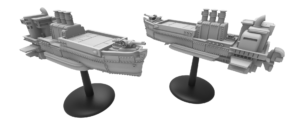
With today’s announcement that pre-orders for Scythe: The Wind Gambit are now available through retailers, I thought I’d share a behind-the-scenes look into the process of designing and refining the airship miniature.
Each of the 7 factions has 1 airship miniature in their faction color, but the sculpts are identical. There are three reasons for this: One, thematically, all airships have the same abilities (the abilities are randomized at the beginning of each game). We tested it both ways, and it worked best this way.
Two, the cost to make a high-quality mould for a miniature this size is about$10,000. Expansions like this are a low-margin product, so adding an additional $60,000 for six more moulds is a significant expense.
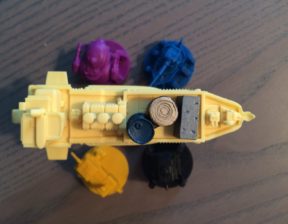 Three–and this is really important–when we get the original sculpt from a 3D modeler, it’s not like we instantly start making miniatures. Rather, it’s the beginning of an extensive process to maximize the durability and aesthetics, as well as exactly how different parts of the mini will fit into the mould (big miniatures like this are often comprised of multiple pieces).
Three–and this is really important–when we get the original sculpt from a 3D modeler, it’s not like we instantly start making miniatures. Rather, it’s the beginning of an extensive process to maximize the durability and aesthetics, as well as exactly how different parts of the mini will fit into the mould (big miniatures like this are often comprised of multiple pieces).
For the Wind Gambit, this process took 2 months for a single miniature. At the end of that process, I actually sent the updated digital model to the original sculptor so he could do some final touch-ups to the updated design. This was particularly important because Panda was in charge of ensuring that workers and resource tokens could fit onto the miniature.
That’s right–airships in The Wind Gambit physically carry workers and resources. That might give you a sense of scale when looking at the image below. The airships are 104mm long, bigger than 3 mechs placed side to side. They’re elevated 40mm above the table on a clear plastic stand (the position and height of which we had to carefully calibrate to ensure good balance).
With this final model in hand, Panda will make the mould next week and start making the 41,000 sets of miniatures for the first print run of The Wind Gambit!



